From rising inflation and labor shortages to Omicron and supply chain issues, it’s no secret that 2022 was filled with challenges for the restaurant industry. Then came the mad rush of the holiday season, filled with its own anxieties and difficulties.
But if you’re reading this, you’ve made it to 2023. Now you have a few slower months to catch your breath before the spring and summer rush begins. After you’ve celebrated all of your accomplishments in the previous year, it’s time to plan ahead.
As you know, things change fast in the restaurant industry, and even faster in restaurant marketing. Make this your best year yet with an up-to-date marketing strategy that can increase brand awareness and drive business. Here are a few ways you can refresh your marketing for 2023.
1. Utilize Social Media
As a restaurant owner, you understand the importance of social media marketing. It’s a cheap and powerful tool that can help you reach new customers, engage with existing ones, and drive business.
Social media can increase brand awareness by using the viral nature of platforms like Facebook, Instagram, and Twitter to get your restaurant in front of a larger audience of potential customers. Consider sharing mouthwatering food photography and content about events, specials, and whatever else you’d like to highlight.
If you want to get the most out of your socials, consider developing a content strategy. During the beginning of the year, get into the habit of spending a few hours at the beginning of each month creating a content calendar that outlines what types of content you’ll be posting, when you’ll be posting, and which platforms you’ll be using.
If you want to increase social media engagement, consider running promotions and contests. While there are many social media contests you could run, start with the classic like, follow, and share. All you have to do is post a photo of your food, beverages, or even a gift card, then in the comments tell users that if they like, follow, and share your post they can win a prize. The prize could be branded swag, a free gift card, or a certain percentage off of their next meal. What makes the like, follow, share contest a hit is that it’s cheap and easy, and it can quickly boost social media engagement.
And if you’ve never collaborated with an influencer, why not give it a try in 2023? A local influencer can help you increase your brand awareness and reach larger audiences. You can search for foodie influencers in your area via Google, or you could spend some time searching Instagram and TikTok.
You can usually find an influencer’s contact information via their social media profile, and as long as they aren’t uber-famous you should be able to swap a free meal for a shoutout on their platform of choice.
Most digital marketing experts suggest aiming for three to four posts per week. This is enough to increase brand awareness and drive business, but not enough to annoy users with constant updates. Three to four posts per week (around 200 posts per year) can be a lot, especially for a busy small business owner. Luckily, services like MustHaveMenus can help. They have hundreds of eye-catching and free social media templates. These templates are easy to customize and come in a variety of styles to fit any brand or event.
2. Use Email Marketing
An email marketing program can be a great way to stay in touch with your customers and spread the word about your restaurant’s specials, events, and promotions. You can start collecting email addresses from customers and other interested parties either by asking them to sign up at your restaurant or on your website. Of course, you’ll want to make sure to ask for consent and abide by privacy and laws.
You can use an email service provider (ESP) to manage your email lists and send out emails for you. Some popular ESPs include MailChimp, Constant Contact, and Campaign Monitor. You can also create a template for your emails that is consistent with your restaurant’s branding.
Like your social media, you should also spend a few hours at the beginning of each month developing a content strategy. Plan out the types of emails you will send and when you will send them. You can send out weekly or monthly newsletters that highlight your menu, specials, and upcoming events, or send out targeted emails for specific promotions or events.
You can also optimize your emails to increase open and click-through rates. Test different subject lines, email content, and call-to-action buttons to see what works best with your audience, and make sure your emails are mobile friendly, since most of your emails will be read on mobile devices.
Finally, make sure to keep your emails relevant, interesting, and not too frequent. If you spam your customers, or send emails that don’t offer any benefit to them, they’ll likely unsubscribe.
3. Optimize Your Website
Optimizing your website can make it easier for potential customers to find and learn about your business, and it can increase the chances of converting them into actual customers.
First, you’ll want to make sure your website is easy to navigate and uses a lot of high-quality images. Consider a landing page with all of your contact information. Things like your name, address, phone number, and hours of operation should be easy to find, and don’t forget some of your more drool-worthy photos to whet the appetite.
The rest of your website content can be spread across a few pages, making it easier for customers to find the information they need without having to wade through long blocks of text. Include pages for your menu, online ordering and reservation systems, social media and online review profiles, and more.
Once you have a well-designed website that is visually appealing and easy to navigate, consider optimizing for search engines by using strategies like relevant keywords, meta descriptions, and alt tags for images.
You should also make sure your website is mobile friendly. These days, search engines like Google and Bing know that consumers search more on their smartphones than on their desktops or laptops. Search engines take this into account when providing returns, preferring websites that are designed to adapt to different screen sizes.
4. Develop a Loyalty Program
A loyalty program can be a great marketing tool, and it can encourage repeat business at your restaurant. There are many different types of loyalty programs to choose from, such as point-based digital programs or visit-based punch card programs.
Point-based digital programs can make it easy for your customers to accrue and redeem points, but they also require a fair amount of technology in the form of POS software or a smartphone app.
On the other hand, an old fashioned loyalty punch card requires nothing more than cardstock, a printer, and a hole punch. Punch card programs are great because they are cheap and easy to start, but they do require customers to keep track of a card and carry it around with them in their wallet or purse.
When it comes to loyalty programs, there isn’t a right or a wrong choice. Pick the program that best fits your restaurant’s brands, needs, and goals. And don’t forget to promote it through all of your marketing channels via your website, in-store materials, and social media.
5. Partner with Local Businesses
Partnering with other local businesses can be a great way to increase visibility, drive traffic, and build relationships within your community. Consider partnering with local hotels and B&Bs to offer package deals that include a stay and a meal at your restaurant, which can be a great way to reach a wider audience and attract tourists.
You can partner with local theaters, offering a date night special that includes two movie tickets and dinner for two. Or you could partner with local retailers such as clothing stores, gift shops, and supermarkets. In exchange for a bit of marketing, you can offer discounts or specials to customers who make purchases at their store and present the receipt at your restaurant.
You can also partner with local events such as festivals and fairs to provide food and drinks to event-goers. This can increase brand visibility and drive foot traffic. Similarly, consider partnering with local organizations like schools, charity groups, and sports teams, providing them a gathering space, meals, and discounts while also supporting their activities and causes.
6. Offer Takeout and Delivery
Offering takeout and delivery is another important way you can market your business and attract customers in 2023. For most restaurants, online ordering can be the best way for both you and your guests to process takeout.
Most customers prefer online ordering because it can be done with only a few taps on their smartphone, and because it puts them in charge of their order. For the restaurant, your staff won’t have to answer that constantly ringing phone during the middle of a dinner rush. An online system can automate the entire process, from ordering to payment processing, meaning your front house staff can focus on providing the best possible customer service to your in-person guests.
If you’re like most restaurants, you don’t have a delivery system of your own. Luckily, it’s easier than ever to partner with a third-party delivery service like Grubhub, DoorDash, or Uber Eats. The best part is they do everything for you. They promote your restaurant and your menu, and they take care of payment processing and delivery. All you have to do is make sure the food comes out of your kitchen at the right time.
Of course, third-party apps charge a fee for their services, but it can be worth it for most. If you aren’t offering delivery, you’re likely losing business to competitors who are.
7. Innovate Your Menu
Incorporating new and upcoming foodie trends can attract customers who are looking for something new, exciting, and different. The first step is staying informed about trends. You can do this by reading industry publications and following food bloggers and influencers.
Incorporating seasonal ingredients can also help you create a sense of novelty and freshness around your menu. You can offer special dishes that feature these ingredients, and change them frequently to keep the menu fresh and up to date.
You can experiment with new flavor combinations and international cuisines to give your customers something unique and intriguing. Consider collaborating with a chef or food creator who can help you incorporate these dishes and cuisines.
You can also offer a variety of dietary options to make sure your menu includes a variety of options for customers with different dietary needs. Offering vegetarian, vegan, and gluten-free dishes makes for great promotional opportunities, and it can set you apart from your competitors.
Of course, innovation will mean a new menu. Your menu isn’t just an inventory of all of your food and drinks. It’s also a key component of your restaurant’s marketing strategy. If you don’t consider yourself a graphic designer, or if finding the time to create a whole new menu sounds overwhelming, you can find beautiful and professionally designed menu templates online. These templates are easy to customize and make launching a new menu a cinch.
Know Your Customer
When you’re refreshing your restaurant for the new year, don’t forget about your ideal customer. Whether it’s a healthy living Instagram account or a trendy and ironic TikTok presence, knowing what kind of marketing your customers respond to is half of the battle.
By tailoring your marketing efforts to appeal to your ideal customer, you’ll be more likely to attract new customers, retain existing ones, and drive business. You can use the next few months to try out different tones and strategies, finding what works for your customer and your brand in 2023 and beyond.






